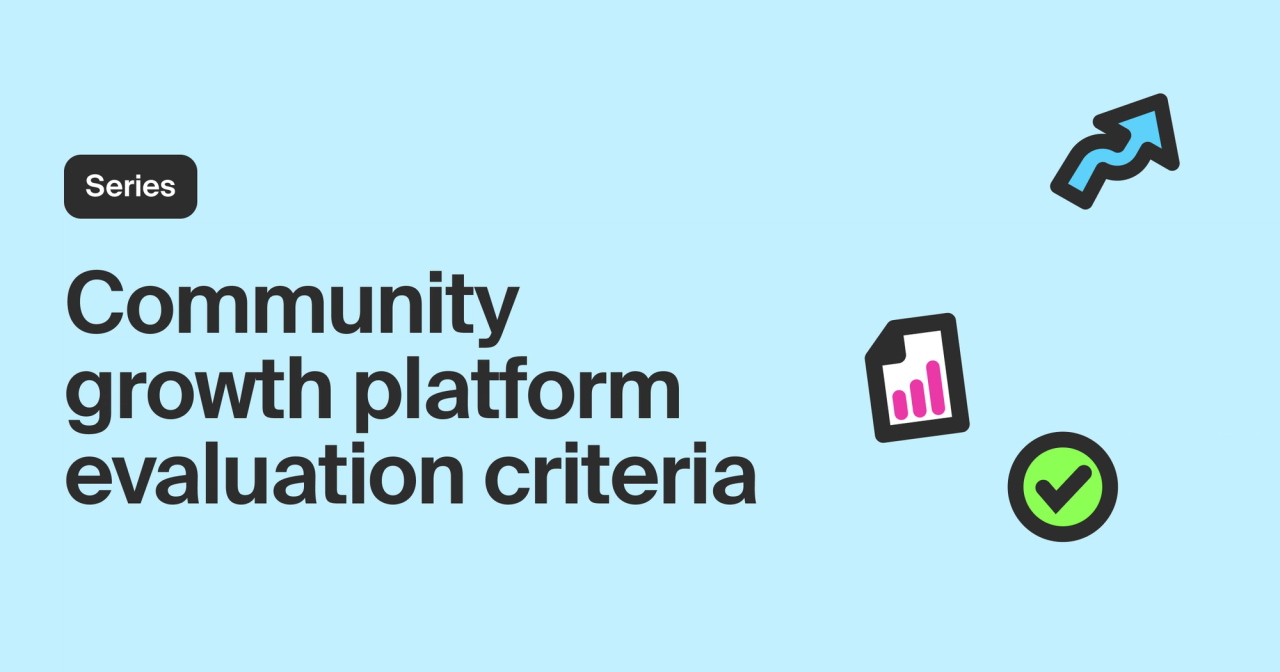In a previous post, we addressed how to approach the process of evaluating community growth platforms. In this next article in the series, we’ll take a deeper look at what you should be seeking out in a community growth platform.
We’ll walk through the key capabilities community managers should consider during the selection process, including:
- Deep member insights
- Activity insights and trends
- Actions in response to member activity
- Community health metrics and reports
- End-to-end community attribution
- Customer references
- Community and customer data security
- Performance and scalability
Each community growth platform may address these key areas differently. Assessing the depth and performance of each of these functional areas in your selection process is a necessary part of making an informed decision that will enable you to successfully pursue community-led growth.
If you’re ready to dive right in, download the free Guide to Evaluating Community Growth Platforms. It includes a complete overview of the benefits that a community growth platform can bring to a team, the critical capabilities and use cases it must support, and a free template to track and score your evaluation.
Key criteria for evaluating community growth platforms
Deep member insights
Whether your community growth strategy leverages two platforms or ten (or more!), your team will want to know whether each solution integrates data from all of the sources you use. For in-depth member insights and analytics, you’ll want to collect community data for a variety of purposes.
You’ll also want to know what kind of insights your team will be able to glean from this data. For a crystal-clear view of member insights, look for a platform that provides unified member profiles across all sources for a true 360-degree view of each member’s activity, sentiment, and engagement.
Here are few questions to ask when evaluating platforms based on their member insight functionality:
- Which sources does the platform integrate with?
- What is the depth of information you can access from each source? (e.g., ability to view historical data in addition to data created after the connection has been established)
- Can integrations be set up in a self-service way (e.g., without the need to involve IT)?
- Will the integrations evolve to support the new capabilities of the underlying platforms?
Activity insights and trends
Monitoring activity insights and trends is extremely important to nurturing engagement across your community. Choosing a community growth platform that surfaces trending conversations to monitor and respond to helps streamline and simplify this key function of community management.
Find out how each platform groups together and surfaces different categories of activity based on what community members are saying, sharing, or feeling. These insights will help your team reach out and respond to community members at the appropriate times and inflection points to show the value of the community or product and deepen your relationship with the member.
Consider asking vendors the following questions:
- Does the platform make it easy to quickly zero-in on important information and route it to the appropriate stakeholders?
- Is it capable of surfacing trending conversation to monitor and respond to?
- Can it help teams get a pulse on how members are feeling by automatically measuring member sentiment?
- Are you able to categorize members based on their unique background and expertise?
Workflows
A straightforward, automated workflow makes rote tasks a lot easier and creates more efficient teams. Complex, manual community-building activities—like sending welcome messages to each new member—can be important, but impede productivity and cause frequent, frustrating disruptions. Finding out which platforms offer a way to streamline and/or automate time-consuming manual tasks will help you identify the right solution to make your team faster and more productive.
Explore each platform’s specific workflows with the following questions:
- What kind of automated workflows does the platform offer to reduce manual work and time-to-insight?
- Are the workflows a natural fit to the way your teams operate?
- Does the platform offer out-of-the-box workflows that can be further customized based on your needs?
Data-driven attribution
To measure your community’s impact on the business—or community-led growth—you need to be able to attribute wins to your community like signups, product usage, renewals, expansions, and revenue generated to your community.
Discover if the platform you’re evaluating supports ingestion, visualization, and analysis of customer- and product-related data. A community growth platform with data-driven attribution functionality will be capable of combining various internal data sources, such as CRMs, data warehouses, reverse ETL tools, and marketing automation systems, with data from the community.
This internal data is combined with community member activity data for attribution, strategic prioritization, and customer journey-mapping.
Ask vendors the following to assess their functionality related to data-driven attribution:
- Do they have product functionality and expertise in combining internal data sources with community data?
- What investments is the vendor making in data science and analytics to better identify insights from this data and help improve the impact of community programs?
- Can the vendor share any credible outcomes (e.g., case studies) delivered for customers in terms of lead attribution, revenue concentration, or other similar analyses?
User functionality
A slow, buggy, or unintuitive UI can ruin user experience and deter your team members from using even the most powerful community growth platform.
Find out how each vendor’s UI responds to searches, queries, and other actions. You’ll also want to be sure the insights and metrics provided will continue to perform as expected as the total volume of data increases.
Each community growth platform may also have different data limits, automation capabilities, and notification systems. Understanding which aspects of the UI include automation, how the platform notifies users of specific actions within the community (e.g., alerts in Slack or email), and how much data the platform can process before hitting a limit will help to narrow down which solution meets the needs of your team.
Ask the following questions to get more clarity on user functionality:
- Does the vendor take user feedback into consideration when shipping new features?
- How often is the product updated and are these changes publicly cataloged?
- Are they able to share customer reviews and/or details about the technical specifications of the platform?
Metrics and reporting
Accurate, data-driven reporting and metrics are another key aspect of your team’s strategy to prove and track the effectiveness of your community growth.
Before making a selection, understand what kind of reporting each community growth platform supports. First and foremost, community growth reporting entails the measurement of community health KPIs and OKRs such as responsiveness, engagement rate, and sentiment. Having this foundation in place will enable you to measure key business metrics later on in your community maturity journey.
Find out if they measure and report on community health KPIs and OKRs, such as responsiveness, engagement rate, and sentiment.
Another factor to consider is whether the community growth platform allows users to customize dashboards for specific reporting needs. Having the capability to build and share reports is often a priority for teams that need to share metrics with internal stakeholders.
Ask vendors the following questions when probing into the metrics and reporting capabilities of each platform:
- Does the reporting support both aggregate and granular reporting types, such as total community membership, engagement, and growth, as well as per community channel?
- Are community report templates provided out of the box?
- Can you download and share reports with key stakeholders?
- Are internal employee activities automatically identified and filterable to ensure data validity?
Security and privacy
With all of the data flowing into and out of your community tech stack, you’ll want to have a complete understanding of the level of data security and privacy each platform provides.
There are a few key points you’ll want to address when assessing vendors on their security and privacy. First, have a checklist of your company’s security needs prior to making an evaluation. Here are some questions that can help compare the needs of your company against the security protocols of the vendors’ solutions.
- Are they SOC 2 Type I and Type II certified (the gold standard of customer data security)?
- Are the processes and capabilities of the solution GDPR and CCPA compliant? Do they have a DPA and privacy policy?
- Do they have completed security and privacy risk assessment forms? Do they conduct ongoing security practices (e.g., penetration tests)?
- What are their advertised uptime and service-level agreements (SLAs)?
User-backed testimonials
Before making a decision, it’s always helpful to crowdsource insights from peers. In addition to reading publicly available reviews, see if the vendor can connect you with existing customers to have a candid conversation about their experience with the platform.
Here are a few questions you can ask vendors to get some insight into their existing customer base:
- Do they already have customers with a similar community size, program objectives, stage of community maturity, etc. as yours?
- Are the logos on their website active, paying customers?
- Do they have their own community where you can interact directly with other users and employees?
How Common Room can enhance your community growth
Are you looking to better understand, activate, and scale your community? Common Room lets you trade your manual spreadsheets for intelligent insights, custom reports, and automated workflows to scale the impact of your team.
Common Room gives companies real-time intelligence and business context to accelerate both community growth and community-led growth against quantifiable goals. The platform pairs AI & ML-powered insights with engagement and reporting capabilities to help community leaders build stronger communities.
We’ve worked alongside today’s fastest-growing companies to scale their community growth efforts and measure impact on the business. To intelligently engage and grow your community, try Common Room for free today or request a demo.
Looking for more resources on selecting a platform? Check out our Guide to Evaluating Community Growth Platforms or connect with 1000+ community and DevRel leaders to share expertise and ask questions in the Uncommon community Slack.

